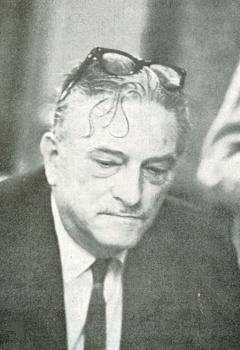
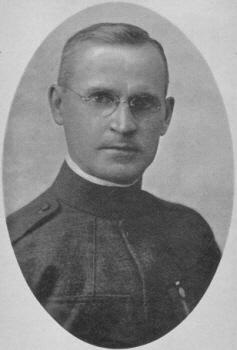
Edward Winter


Al Horowitz and Francis J. Wellmuth
A book review on page 88 of the September-October 1943 American Chess Bulletin stated regarding Francis J. Wellmuth that ‘practically a lifetime was spent by the editor, now in his 70s, in keeping abreast of the activities of the world’s best players and making careful selection of their games, going back also as far as the time of Ruy López’. Why, then, was Wellmuth’s name later removed from the book, The Golden Treasury of Chess, with authorship eventually credited to Al Horowitz?
To return to basics, below is a descriptive list of the various editions of the Treasury in our collection:
1. A hardback published in the ‘chess classics series’ by David McKay Co., Philadelphia, 1943 (304 pages). The title page stated The Golden Treasury of Chess compiled by Francis J. Wellmuth, and the frontispiece was a full-page photograph of him (reproduced by us above). The imprint page had ‘Copyright, 1943 by Horowitz & Harkness, New York, N.Y.’. Page v was an introduction by Frank J. Marshall dated January 1943 which mentioned Wellmuth by name in the following paragraph:
‘The title at once brings to mind one of the most beloved books in the English language. As we all know, it was Palgrave’s object, when he assembled the beautiful poems which comprise The Golden Treasury, to gather into one convenient volume the choicest productions of our literature through several centuries. Mr Wellmuth has had in mind precisely the same goal with respect to chess, and the result has been a really magnificent compilation of fine games.’
The book contained, on page viii, a 1902 acrostic by Wellmuth as a tribute to ‘Harry Nelson Pillsbury’, to whom the book was dedicated. There were 540 games, including four played by Wellmuth.
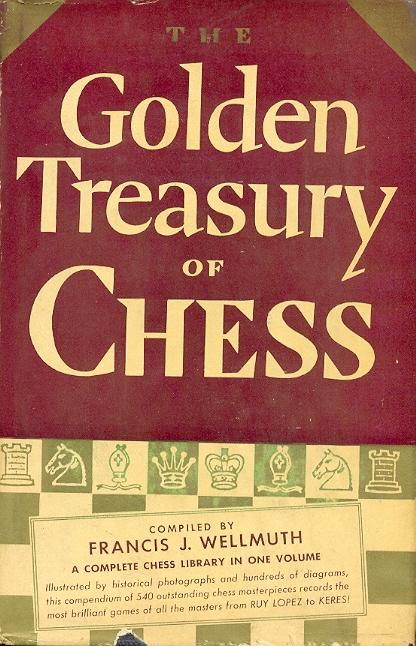
2. A ‘First Edition Limited to 500 copies’ signed by Wellmuth. The same contents as the above book, except that on the title page the publisher was not McKay, Philadelphia but ‘New York Horowitz & Harkness’.
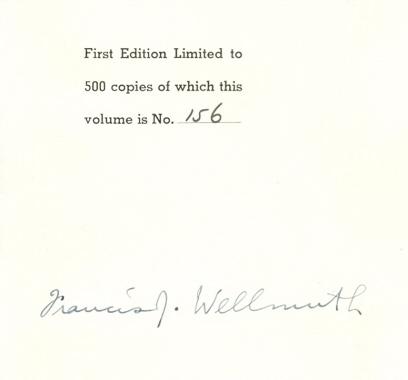
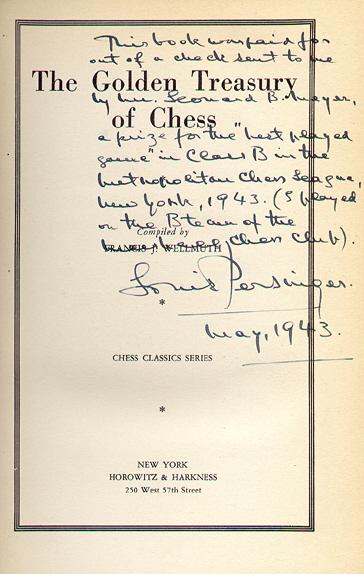
Inscription by Louis Persinger in one of our copies of the signed limited edition of Wellmuth’s 1943 book
3. A hardback revised edition from Harvey House, New York (326 pages), the title page of which said ‘Compiled by The Editors of Chess Review’. The imprint page had ‘Copyright, 1943 By Horowitz & Harkness’ and ‘Copyright, 1956 By I.A. Horowitz’. Marshall’s Introduction (with its reference to Wellmuth) and Wellmuth’s own introductions (with the first person singular pronoun) were still there, as were Wellmuth’s four games, but the acrostic had gone, as had the frontispiece photograph of Wellmuth, who was mentioned nowhere as the author or compiler. A Part VII (‘The Period of Russian Hegemony’) was added (on pages 299-320), comprising 31 games played between 1943 and 1956.
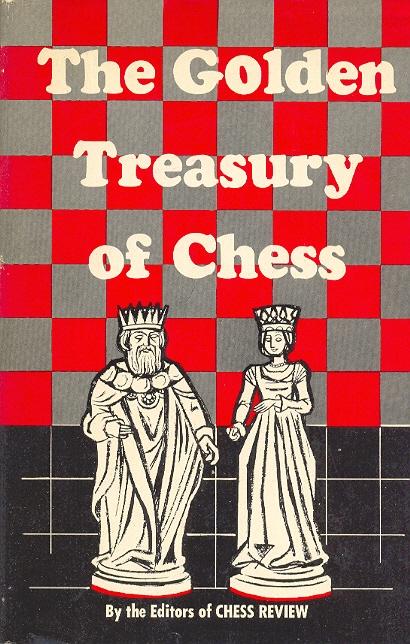
4. A hardback edition from Arco Publications Limited London, identical to the previous item, except that the imprint page stated ‘Copyright in England, 1958’ and all the photographs in the above editions were omitted.

5. A paperback edition published by Barnes & Noble in 1961 (328 pages), with authorship ascribed on the title page as: ‘Compiled by Al Horowitz and The Editors of Chess Review.’ The imprint page had ‘Copyright, 1943 by Horowitz & Harkness’ and ‘Copyright, 1956, 1961 By I.A. Horowitz’, as well as the following: ‘Published in 1961 by Barnes & Noble, Inc. by special arrangement with Z.E. Harvey, Inc.’ There was a second printing in 1962. A further four games were added, from the period 1956-60, making a total of 575.
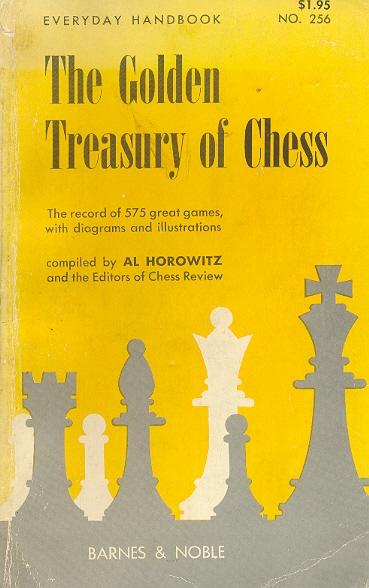
6. A hardback edition from Galahad Books, New York City (191 pages), again with ‘Compiled by Al Horowitz and The Editors of Chess Review’ on the title page. The imprint page stated: ‘Copyright 1969, 1961, 1956 by I.A. Horowitz. Copyright 1943 by Horowitz and Harkness.’ Marshall’s Introduction, with its reference to Wellmuth, had gone. Although 11 games were added from 1962 to 1966, many of the earlier games (including all four of Wellmuth’s) were removed, and there were only 322 in total.
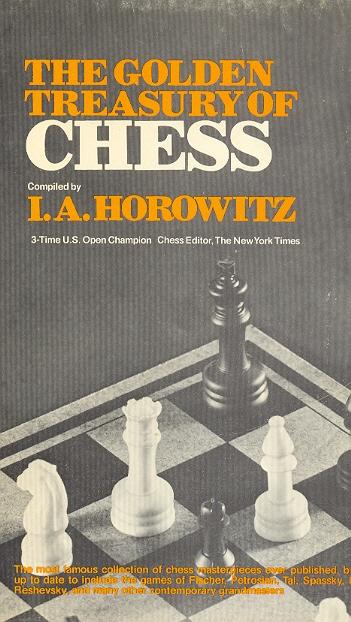
7. Various paperback reprints (from 1969 to 1978) by Cornerstone Library, New York, of the preceding edition, although the imprint page stated: ‘This completely new revised edition is published by arrangement with I.A. Horowitz and Harvey House, Inc.’ The later reprints of this paperback had an extra game (won by Tal in 1964) on the previously blank page 186.
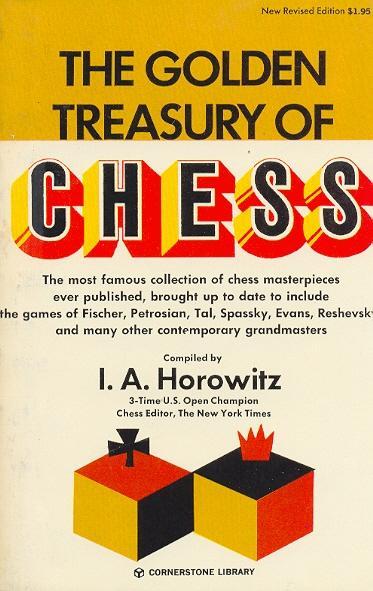
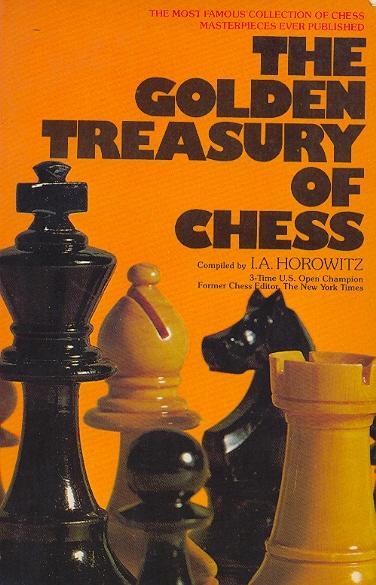
Wellmuth’s introduction to Part I in the original 1943 edition (page 1) included the following:
‘In the course of the decades which I have devoted to the preparation of this volume, I have had occasion to examine thousands upon thousands of scores. Those that have pleased me most are included in The Golden Treasury of Chess. But even among these favorites, there are some which I have enjoyed so much that I have set them aside in order to attract the reader’s attention to these games. I will not deny that ten years ago I might have selected other games, and that in the years to come, my tastes will again be modified. Nevertheless you will be delighted with these games.’
These personal words from Wellmuth were still there in the latest edition of the book that we have seen (1978), even though acknowledgement of his authorship of the book had long since been dropped. Indeed, we were about to write that Wellmuth’s name never appeared on any title page after the original 1943 editions, until we noted that according to page 274 of Douglas A. Betts’ Bibliography the 1943 book was ‘issued in Great Britain by Pitman, 1947’. Having never seen that UK version, or found it mentioned in various other bibliographical listings, we should like to hear from any reader who owns a copy.
(3722 & 3793)
To the Chess Notes main page.
To the Archives for other feature articles.
Copyright: Edward Winter. All rights reserved.